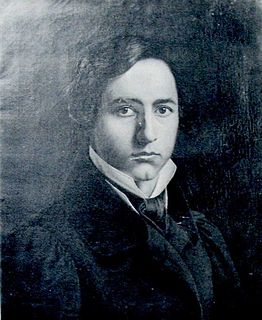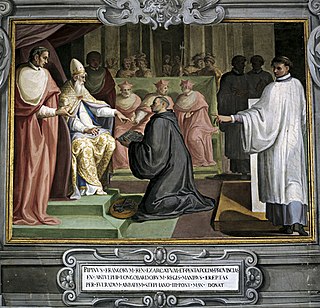
Primate is a title or rank bestowed on some archbishops in certain Christian churches. Depending on the particular tradition, it can denote either jurisdictional authority or (usually) ceremonial precedence.

The Barnabites are Catholic priests and Religious Brothers belonging to the Roman Catholic religious order of the Clerics Regular of St. Paul, founded in 1530. While they used to use the postnominal initials of simply "B.", they currently use C.R.S.P. Associated to the members of the Order are the Angelic Sisters of St. Paul and the lay members of the Barnabite lay movement.
Abbé is the French word for abbot. It is the title for lower-ranking Catholic clergymen in France.
Confessor is a title used within Christianity in several ways.
Heinrich Wangnereck was a Catholic theologian, preacher, author. He was born in Munich. The extant sketches of his life give no uniform information respecting the dates of events; it is, however, unanimously stated that when sixteen years old he entered the novitiate of the upper German province of the Society of Jesus, at Landsberg, took the usual course of instruction, and in addition was for a time teacher of the lowest class at the gymnasium. His chief occupation was that of a professor of philosophy and theology at the University of Dillingen, where he was chancellor, according to one statement, for twenty-four years. In addition to teaching, he was also a noted preacher. In 1655 he was sent to Lindau as superior and missioner, but after five years returned to Dillingen where he was chancellor until his death, which followed a sudden stroke of apoplexy at table. It is said that his reputation for learning and ability was so widespread that many secular and spiritual princes, bishops, and prelates of Germany asked his advice in the most important matters. His works, of which twenty are known, are chiefly on theological subjects. He also took part in the political controversies of the period, but not always to the satisfaction of authority, as there is record of a punishment inflicted upon him by the general of the Society because he had spoken disrespectfully of the Duke of Bavaria. His first small work, "Notae in confessiones S. Augustini", published in 1630, has retained its popularity up to the present time; in 1907 a fourth edition of it appeared.

Franz Ittenbach was a German religious painter from Königswinter, at the foot of the Drachenfels.
Examination of conscience is a review of one's past thoughts, words, actions, and omissions for the purpose of ascertaining their conformity with, or deviation from, the moral law. Among Christians, this is generally a private review; secular intellectuals have, on occasion, published autocritiques for public consumption. In the Catholic Church penitents who wish to receive the sacrament of penance are encouraged to examine their conscience using the Ten Commandments as a guide, or the Beatitudes, or the virtues and vices. A similar doctrine is taught in Lutheran churches, where penitents who wish to receive Holy Absolution are also asked to use the Ten Commandments as a guide. The process is very similar to the Islamic practice of Muhasaba, or self-reflection.
Approbation is, in Catholic canon law, an act by which a bishop or other legitimate superior grants to an ecclesiastic the actual exercise of his ministry.
Obreption and subreption are terms used in ancient Roman law and in the canon law applied by the Catholic church to species of fraud by which an ecclesiastical rescript is obtained.
Eugenius I was Archbishop of Toledo from 636 to 646. He became successor in 636 of Justus in that metropolitan see. Like his predecessor he had been a disciple of Helladius in the monastery of Agali. He is famous as an astronomer and astronomical mathematician.
A celebret is a letter which a Roman Catholic bishop or major religious superior gives to a priest in order that the priest may obtain permission in another diocese to say Mass, and for this purpose bears testimony that he is free from canonical censures.

François Vachon de Belmont was the fifth superior of the Montreal Sulpicians from 1700 to 1731. Vachon de Belmont was born in Burgundy, France to a wealthy family. He moved to Canada and personally funded the construction of La Montagne mission near Montreal.

John Justus of Landsberg was a German Carthusian monk and ascetical writer.
William Henry Anderdon was an English Jesuit and writer, born in London.
Canonical faculties, in the canon law of the Roman Catholic Church, are ecclesiastical rights conferred on a subordinate, by a superior who enjoys jurisdiction in the external forum. These rights then allow the subordinate to act, in the external or internal forum, validly or lawfully, or at least safely.

Papal appointment was a medieval method of selecting a pope. Popes have always been selected by a council of Church fathers, however, Papal selection before 1059 was often characterized by confirmation or "nomination" by secular European rulers or by their predecessors. The later procedures of the papal conclave are in large part designed to constrain the interference of secular rulers which characterized the first millennium of the Roman Catholic Church, and persisted in practices such as the creation of crown-cardinals and the jus exclusivae. Appointment might have taken several forms, with a variety of roles for the laity and civic leaders, Byzantine and Germanic emperors, and noble Roman families. The role of the election vis-a-vis the general population and the clergy was prone to vary considerably, with a nomination carrying weight that ranged from near total to a mere suggestion or ratification of a prior election.

From 756 to 857, the papacy shifted from the orbit of the Byzantine Empire to that of the kings of the Franks. Pepin the Short, Charlemagne, and Louis the Pious had considerable influence in the selection and administration of popes. The "Donation of Pepin" (756) ratified a new period of papal rule in central Italy, which became known as the Papal States.
Edmond Richer was a French theologian known for several works advocating the Gallican theory, that the Pope's power was limited by authority of bishops, and by temporal governments. He was born in Chaource.
The Synod of Milan or Council of Milan may refer to any of several synods which occurred in late Roman Mediolanum or medieval Milan in northern Italy's Po valley:
Christian Latin literature has a long history with its foundations being laid during the 4th and 5th centuries. They included the church fathers Augustine of Hippo, Jerome, and Ambrose, and the first great Christian poet, Prudentius.









